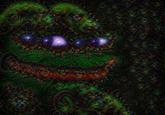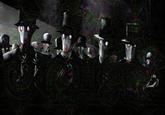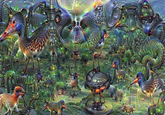Google DeepDream
Part of a series on Google. [View Related Entries]

| Navigation |
| About • Origin • Spread • Various Examples • Search Interest • References • Recent Images • Recent Videos |
About
The Google DeepDream code is an artificial intelligence program created by scientists at Google that generates pictures based on the visualizations of artificial neural networks by spotting details in pictures and attempting to identify them. After Google made the code publicly available, creating custom images, GIFs, and video using the program became popular online.
Origin
On June 17, 2015, Google Research Blog's post "Inceptionism: Going Deeper into Neural Networks" described how the neural network AI analysis exploits certain features it recognizes and enhances based on images it has already seen, thereby creating figures in the image that Google referred to as neural network "dreams."[1]
On July 1, 2015, the Google Research blog released the "DeepDream" code, created by Software Engineers Alexander Mordvintsev, Christopher Olah, and Mike Tyka in the Python language, as open-source via GitHub and encouraged users to share their image processing results using the hashtag "#deepdream."[2][3] Some users created websites that use the DeepDream code to modify images, so as to create user interfaces for non-programmers or those not familiar with inputting images into Python code.[4][5]


Spread
Upon the release of the code, which was widely publicized,[12] users began using the hashtag in droves to demonstrate their use of the tool. Between July 1st and July 6th, 2015, over 10,000 posts on Twitter have used the hashtag "#deepdream."[9]
On July 3, 2015, Twitter user "@One_30_One" tweeted a modified version of a poster from the anime series Love Live! using the code (image below, left), with the caption "Oh lord what have I done #deepdream #lovelive @LoveLive_staff", receiving more than 170 retweets and 110 favorites.[6] On the same day, The University of Cambridge posted a picture on Instagram of the campus' famous Corpus Clock modified by Deep Dream (image below, right) with the caption "We ran the #chronophage through Google's #deepdream algorithm. Is it the first photo to become less surreal after conversion? #CambridgeUniversity #clock" and received over 900 likes.[7]


It has also become a trending topic on Facebook and Instagram, where more than 1000 posts have been created with the hashtag.[13] The subreddit r/deepdreams has over 800 subscribers as of July 2015[10]. Reddit user TheMadStork posted a gif generated using the code on r/creepy and was frontpaged with more than 3000 upvotes and 400 comments[11].
by Ross Goodwin (<a rel="nofollow" target="_blank" href="http://rossgoodwin.com">http://rossgoodwin.com</a>)
YouTube user Roelof Pieters ran a scene of the film Fear and Loathing in Las Vegas through the Deep Dream program, and uploaded the clip to YouTube, where it received 27,00 views in three days.
Various Examples






Search Interest
References
[1] Research Blog – Inceptionism: Going Deeper into Neural Networks
[2] GitHub – google/deepdream
[3] Research Blog – DeepDream – a code example for visualizing Neural Networks
[4] Psychic VR Lab – Deep Dream web interface
[6] Twitter – Colin on Twitter…
[7] Instagram – University of Cambridge on Instagram…
[8] Gizmodo – Google's Dream Robot Is Running Wild Across the Internet
[10] Reddit – Dreaming Neural Nets
[11] Reddit – Terrifying GIF made with Google's Deep Dream code [x/CreativeCoding] : creepy
[12] Telegraph – Google unleashes machine dreaming software on the public, nightmarish images flood the internet
[13] Instagram – Search: #deepdream





















Comments ( 115 )
Sorry, but you must activate your account to post a comment.
Please check your email for your activation code.